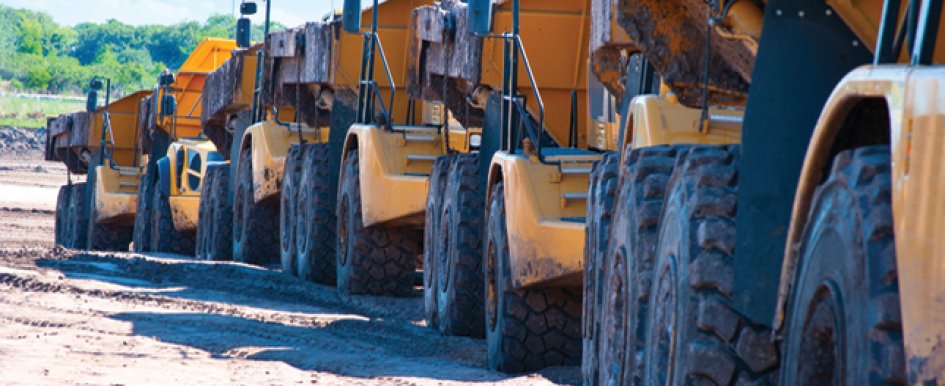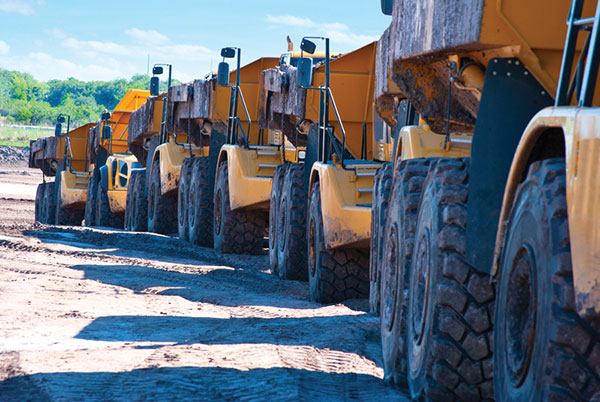
Vehicles keep your business running. Whether you have one truck or an entire fleet, fuel and service activities will comprise a great deal of your operating expenses. Consequently, anything you can do to keep those costs in check helps maximize your bottom line. Regular preventative maintenance is key, but being in the construction industry poses challenges to fleet operation, namely vehicle alignment. Despite the challenges, keeping proper alignment of all of your cars and trucks will save you time, money and plenty of headaches.
Construction sites are full of potential hazards for your vehicles. Although they are an unavoidable part of any job, unforeseen obstacles or heavy loads can wreak havoc on your suspension and steering linkages. The resulting damage can lead to much more than an ill-handling vehicle. Over time, subtle deviations from the factory-preferred settings can lead to uneven tire wear, poor fuel economy and hazardous driving conditions. When detected early, however, improper alignment can be a mere hiccup in your schedule and budget.
Early Detection
The most simple and efficient way to detect improper alignment is for vehicle operators to monitor the driver’s seat and steering wheel. You’ll probably never notice good alignment, but once your car or truck starts pulling to one side or becomes more difficult to operate at higher speeds, the symptoms are obvious. Misalignment is likely to blame for these dangerous conditions.

Before making a final diagnosis, take a close look at your tires. With a tire gauge, check the pressure settings on all four corners. If the measurements are significantly different from the recommended settings (found in the owner’s manual or inside the driver’s side door), then improper tire pressure could be the problem. If, on visual inspection, you see consistently uneven wear across the face of your tires, then the evidence does support an alignment issue. Simply put, a few minutes of investigation could narrow down the probable cause and potentially save on a costly repair bill.
When left unattended, improper alignment will only grow worse, so you must address the problem as soon as possible. If the problem is overlooked for too long, you could already be on the hook for a fresh set of rubber. A vehicle incapable of tracking straight down the road is also a safety hazard to the driver, the fleet and company.
From a fuel economy perspective, your original settings are established with efficiency in mind. A vehicle that does not have all wheels aligned correctly is taking on additional rolling resistance, necessitating more frequent trips to the gas pump. In addition, a tire making contact with the road at an undesirable angle is likely going to have less usable life, potentially resulting in a blowout or higher maintenance costs for damage to other vehicle components.
Making Adjustments
Alignment primarily consists of three measurements: caster, camber and toe. Fleet vehicles typically do not allow for caster adjustment, but the other two settings can affect your ride.
Camber dictates the lateral contact patch that a tire has with the road. For a daily driver, negative camber (top of the tire leaning in toward the vehicle) allows for better cornering stability and maximizes the amount of rubber that can grip the road. Too much camber in either direction will give the tire less surface area to dissipate cornering force.
Toe refers to the degree to which the front of the tire points toward or away from the centerline of the vehicle. Most rear-wheel drive vehicles come from the factory with a slight toe-in (positive toe), which means that front tires are angled inward toward one another. Once in motion, toe-in tires will be forced toward parallel alignment and will give better steering control. Before you go cranking on the steering and suspension parts, however, you should know both the factory-recommended settings and your car or truck’s current settings.
Suggested toe and camber angles will typically be beyond the scope of an owner’s manual. But luckily, online resources are available if you are the do-it-yourself type. A web search for your year, make, model and “alignment specs” should turn up the correct settings. Note that if your vehicle happens to be outfitted with an aftermarket suspension, then additional factors must be considered.
A number of easy-to-use tools are available for checking your vehicle’s alignment. When selecting the right device for your application, first consider your wheel type, as there are multiple methods for attaching an alignment tool to your wheels. Some use magnets, others attach to the lip of the wheel and have screw adjustment. These tools will cost $60 to $300, depending on the type of vehicle, wheels and measurements.
If you have a mechanic on site and a sizeable company fleet, the purchase of alignment equipment is a no-brainer. Saving one set of tires annually, which is a reasonable assumption for a large fleet, more than pays for this upfront investment. Because setup takes only a few minutes, regular use of this type of tool can be simple and routine, just like monitoring your tire pressure. Even if the fleet is largely trouble free, adding regular alignment checkups and tire rotation to your preventative maintenance schedule is highly recommended.
By keeping in tune with your vehicles, you will be able to stay ahead of any major alignment issues. If you are running an entire fleet, be sure to pass this mindset to all of your drivers. Being proactive can keep your business and your vehicles headed in the right direction.
